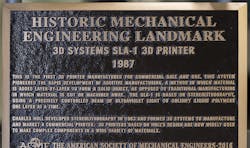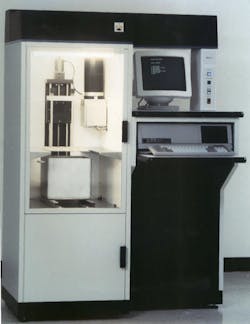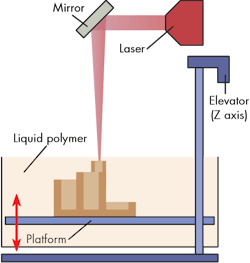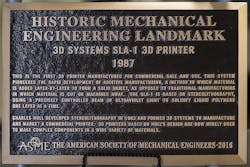On May 18, 2016, the American Society of Mechanical Engineers (ASME) named its 261st Historical Mechanical Engineering Landmark. Invented in 1983 and patented in 1984, the stereolithography (SLA) process developed by Charles Hull would eventually be called 3D printing. By 1987, the first SLA commercial 3D printer was produced, fittingly called SLA-1 (pictured below). Hull would later become a co-founder of 3D Systems.
SLA is a photopolymerization process in which a build tray is submerged 0.002 to 0.006 in. (0.05 to 0.15 mm) in a basin of liquid photosensitive material (see below). This depth can vary based on laser strength, material, or tolerance desired. A UV laser (not lamp) solidifies one slice of the part onto the build tray. The tray then submerges another 0.002 to 0.006 in., and the laser solidifies the next slice of the part. The thickness of the layers can affect the quality of print and tolerances. An industry average tolerance is around 3.9 × 10-3in. (0.1 mm). The laser travels the entire path of the part’s cross-section as it builds up each layer, so speed becomes an important consideration.
Over time, we’ve seen other companies enter the market, especially since 3D printing helps automate the manufacturing process. Taking automation several steps further, 3D Systems this year released "Figure 4," which automates processes more extensively and reduces the time to make a part by a factor of five. Check out the video:
However, the landmark is for the machine that started it all—the SLA-1. Today, rapid prototyping has become a leading technology for the manufacture of new products and parts, with its influence impacting the medical, automotive, and aircraft industries, among others.




